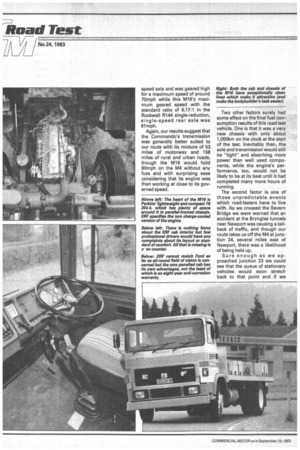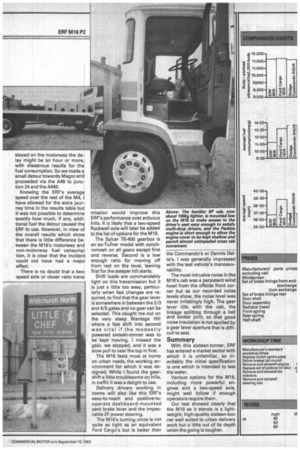Where will the Ml6 lead ERF
Page 33

Page 34

Page 35

If you've noticed an error in this article please click here to report it so we can fix it.
With this vehicle the San dbach firm is hoping to break into the volume 16-tonner market, a sector with which it is unfamiliar. After our Welsh road test, Tim Blakemore feels it is well suited for urban running but not the wide open spaces
ONE THING that ERF's new 16ton model is not is simply an updated version of the original M-Series. That range fitted with Gardner or Dorman engines was introduced in 1978 and only ever sold in small numbers — as few as 25 units a year over the past three years.
ERF's target for the first year of M16 production is to build and sell one a day. The new model is aimed squarely at the volume 16-ton-gvw market sector, which is traditionally dominated by Leyland, Ford, Bedford and Karrier. ERF's engineers knew that if they were to win conquest sales from these manufacturers the M16 would have to have a lower kerb weight than any 16-tonner previously built at Sandbach and be very competitively priced. Our test vehicle certainly had both these attributes.
As the comparison chart on page 33 shows there is little or nothing to choose in kerb weights between the M16 and a similar wheelbase Ford Cargo 1615 or Dodge Commando. Since the MI6's cab is basically the same smc panelled, steel framed SP model as ERF uses for its topweight tractive units (the only major difference being the sixteen-tonner cab's lower mounting and different floor pan) that is quite remarkable.
Our test vehicle, fitted with a Boalloy platform body, carried a very healthy payload of just over 11 tonnes. What operator of sixteen tonners would not be satisfied with that?
Much of the weight saving on the new model stems from the use of the compact Perkins T6 354.4 engine, but a light, hightensile steel chassis frame, minimum leaf springs and a small aluminium fuel tank and aluminium air reservoirs all also help to trim off the pounds.
It would seem that weight and cost-saving considerations also lie behind ERF's decision to use the non charge-cooled version of the T6 354.4 rather than the air-to-air charge-cooled, slightly more powerful one, preferrec Karrier (CM Commando r test, October 31, 1981).
There are only small ferences between the perk) ance curves of these two enq. variants but the results of tests suggest that at 16 tons these could make quite sig cant differences in terms of the-road vehicle performance
The Commando's overall economy for example, at ; lit/100km (13.57mpg), substantially better than ERF's 25.25 lit/100 (11.19mpg) while a compari of average speeds on the Wi route also favours the Dodge It is not that the charge-coc Perkins has a consistently be specific fuel consumption 1 the non charge-cooled eng indeed at peak power the lz variant's sfc is measurez tower than that of the ri powerful engine. But at rr mum torque, the two engi sfc's are virtually identical yet maximum torque is hii for the charge-cooled and, more importantly, its que curve is a lot flatter ma for greater flexibility.
However, other factors shi be taken into account v+, comparing the ERF's per-ft ance with the Dodge's. Not least important of these is g ing. Though both test vehi were equipped with six-sr synchromesh gearboxes — M16 having Spicer's T6-400 the Commando, Dodge's six-speed model — that is wl any similarity ends.
The Commando had a 1 speed axle and was geared high for a maximum speed of around 70mph while this MI6's maximum geared speed with the standard ratio of 6.17:1 in the Rockwell R144 single-reduction, single-speed rear axle was 61mph.
Again, our results suggest that the Commando's transmission was generally better suited to our route with its mixture of 53 miles of motorway and 158 miles of rural and urban roads, though the M16 would hold 60mph on the M4 without any fuss and with surprising ease considering that its engine was then working at close to its governed speed. Two other factors surely had some effect on the final fuel consumption results of this road test vehicle. One is that it was a very new chassis with only about 1,000km on the clock at the start of the test. Inevitably then, the axle and transmission would still be "tight" and absorbing more power than well used components, while the engine's performance, too, would not be likely to be at its best until it had completed many more hours of running.
The second factor is one of those unpredictable events which road-testers have to live with. As we crossed the Severn Bridge we were warned that an accident at the Brynglas tunnels near Newport was causing a tailback of traffic, and though our route takes us off the M4 at junction 24, several miles east of Newport, there was a likelihood of being held up.
Sure enough as we approached junction 23 we could see that the queue of stationary vehicles would soon stretch back to that point and if we stayed on the motorway the delay might be an hour or more, with disastrous results for the fuel consumption. So we made a small detour towards Magor and proceeded via the A48 to junction 24 and the A449.
Knowing the ERF's average speed over the rest of the M4, I have allowed for the extra journey time in the results table but it was not possible to determine exactly how much, if any, additional fuel the detour caused the ERF to use. However, in view of the overall results which show that there is little difference between the MI6's motorway and non-motorway fuel consumption, it is clear that the incident could not have had a major effect.
There is no doubt that a two speed axle or closer ratio trans
mission would improve this ERF's performance over arduous hills. It is likely that a two-speed Rockwell axle will later be added to the list of options for the M16.
The Spicer T6-400 gearbox is an ex-Tutner model with synchromesh on all gears except first and reverse. Second is a low enough ratio for moving off from rest on the level, leaving first for the steeper hill starts.
Shift loads are commendably light on this transmission but it is just a little too easy, particularly when fast changes are required, to find that the gear lever is somewhere in between the 2/3 and 4/5 gates and no gear can be. selected. This caught me out on the, very steep Wantage Hill where a fast shift into second was vital if the modestly powered sixteen-ton ner was to be kept moving. I missed the gear, we stopped, and it was a slow pull to near the top in first.
The M16 feels most at home on urban roads, the working environment for which it was designed. While I found the gearshift a little troublesome on hills, in traffic it was a delight to Use.
Delivery drivers working in towns will also like this ERF's easy-to-reach and positive-tooperate dashboard-mounted park brake lover and the impeccable 2F power steering.
The MI6's turning circle is not quite as tight as an equivalent Ford Cargo's but is better than the Commando's or Dennis Delta's. I was generally impressed with the test vehicle's manoeuvrability.
The most intrusive noise in the MI6's cab was a persistent wind howl from the offside front corner but as our recorded noise levels show, the noise level was never irritatingly high. The gear lever tilts with the cab, the linkage splitting through a ball and socket joint, so that good noise insulation is not spoiled by a gear lever aperture that is difficult to seal.
SLIMillary With this sixteen-tonner, EFiF has entered a market sector with which it is unfamiliar, so inevitably the initial specification is one which is intended to test the water.
Various options for the M16, including more powerful engines and a two-speed axle, might well follow if enough operators require them.
Our test showed clearly that the M16 as it stands is a lightweight, high-quality sixteen-tonner well suited to urban delivery work but a little out of its depth when the going is tougher.




























































































































